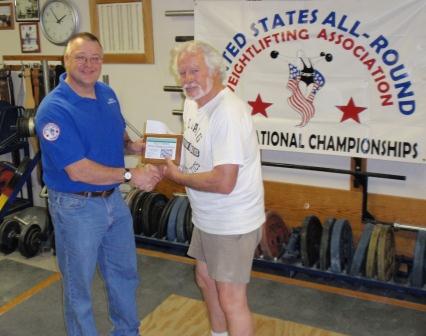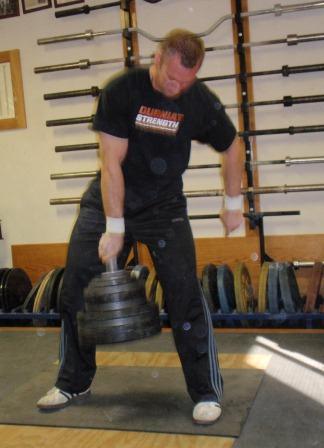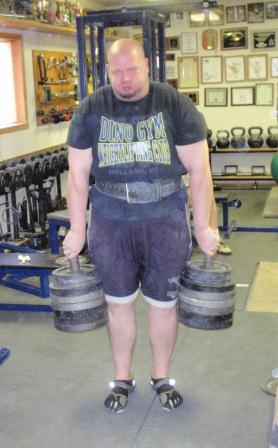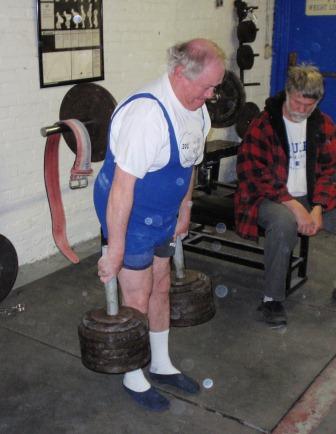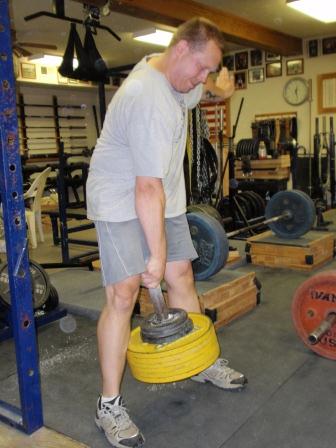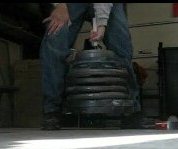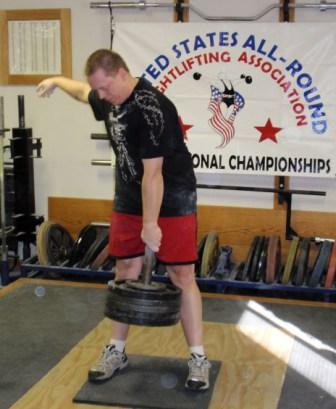Grip Championships
by Al Myers
2013 USAWA GRIP CHAMPIONSHIPS
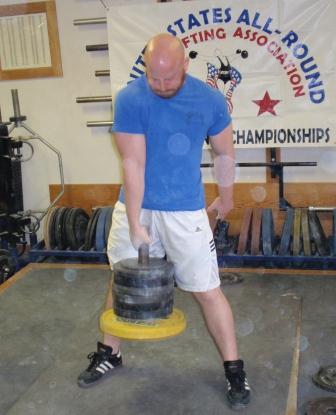
Troy Goetsch lifting 260 pounds on the One Hand 2" Vertical Bar Deadlift. Troy won BEST MENS OVERALL LIFTER at the 2013 USAWA Grip Championships.
Since the first OFFICIAL USAWA Grip Championships in 2011, this meet has seen more lifters entered each year. 2011 had 8 lifters, 2012 had 11 lifters, and this year we had 16 lifters! If the Grip Championships continually experiences this type of growth it will not be long and this will be the most attended yearly meet in the USAWA.
I was amazed at the quality of lifting that took place. The Mens Division was STACKED. Troy Goetsch, of Jobes Steel Jungle, came out as the BEST OVERALL MENS LIFTER in the end. Ruth Jackson added another title to her USAWA resume with taking the BEST OVERALL WOMENS LIFTER. Dan Wagman finished second overall, and LaVerne Myers surprised everyone with his third place overall finish. I predicted there would be some ALL TIME RECORDS broken – and Troy made sure that happened! His 255# Pinch Grip and his 260# 1 hand VB DL are now new USAWA All Time Records. He made these lifts look easy and performed them in impeccable form. My next predication is that he will up both of these records within the next year.
Darren Barnhart had an excellent meet, and if not for Troy being present, would have had numbers at the very top. Darren did a Pinch Grip with 250#, and had a very close miss at 275#. He posted the second highest total (780 pounds) behind Troy’s total (860 pounds). LaVerne Myers may have ended up in third, but he was NUMBER ONE for best dressed. He showed up sporting a new matching stylish short & shirt, complete with new lifting shoes. This must have given him a surge of confidence, because he ended the meet with a Personal Record in the Deadlift – Fulton Bar, Ciavattone Grip of 300 pounds! Ken Glasgow needs mentioned as well. Ken was the oldest lifter that competed, at age 76. I was very impressed with his lifting. Mike Pringle made his “USAWA debut” in this meet. Mike lifted very well, and I hope to see more of him in USAWA competitions in the future. Denny Habecker came the farthest for the meet, from Lebanon, PA. This makes the second meet in less than a month that Denny has attended at the Dino Gym!
I have several people I want to personally thank. First – my wife Leslie who made the lunch and provided numerous other meals to lifters over the weekend. Next, I couldn’t have done this without the help of Chuck Cookson, who did ALL the loading. Chuck laid off competing to load instead, which is critical for a meet to run efficiently. I also want to mention Terry Barlet , who made the road trip with Denny. I talked him into taking all the meet pictures. I will have these pictures available on our USAWA Facebook Page later this week. This Grip Championships had participants from several states – Kansas, Pennsylvania, Colorado, Nebraska, Iowa, Missouri, and Oklahoma. I felt VERY HAPPY about the success of the meet. Thanks again to all those who attended! It’s this type of support that keeps these events going in the USAWA.
(Dan Wagman video recorded the meet and has placed the videos on his website – http://jopp.us/2013grip.html)
MEET RESULTS:
2013 Grip Championships
Dino Gym
Abilene, Kansas
Saturday, February 9, 2013
Meet Director: Al Myers
Scorekeeper/Timekeeper/Announcer: Al Myers
Loader: Chuck Cookson
Photographer: Terry Barlet
Caterer: Leslie Myers
Officials (3-official system used): Al Myers (head), Denny Habecker, Darren Barnhart, LaVerne Myers, Mike Murdock, Chad Ullom
Lifts: Pinch Grip, Vertical Bar Deadlift – 1 Bar, 2″, One Hand, Deadlift – Fulton Bar, Ciavattone Grip
WOMENS DIVISION
| LIFTER | AGE | BWT | PINCH | VB | DL | TOT | PTS |
| Ruth Jackson | 51 | 108 | 107 | 110R | 135 | 352 | 539.1 |
EXTRA LIFTS FOR RECORD:
Ruth Jackson: Vertical Bar Deadlift, 2″, Right Hand 120#
MENS DIVISION
| LIFTER | AGE | BWT | PIN | VB | DL | TOT | PTS |
| Troy Goetsch | 26 | 199 | 240 | 260R | 360 | 860 | 770.5 |
| Dan Wagman | 50 | 183 | 200 | 180R | 280 | 660 | 688.4 |
| LaVerne Myers | 68 | 247 | 180 | 180R | 300 | 660 | 679.6 |
| Darren Barnhart | 45 | 305 | 250 | 205R | 325 | 780 | 595.5 |
| Dave Glasgow | 59 | 252 | 181 | 170R | 275 | 626 | 593.5 |
| Denny Habecker | 70 | 193 | 125 | 130R | 235 | 490 | 585.0 |
| Chad Ullom | 41 | 252 | 180 | 200R | 326 | 706 | 568.9 |
| Bryan Benzel | 25 | 290 | 240 | 210R | 320 | 770 | 567.9 |
| Mark Mitchell | 52 | 313 | 230 | 150R | 325 | 705 | 567.8 |
| Mike Pringle | 37 | 193 | 150 | 165L | 250 | 565 | 514.9 |
| Ken Glasgow | 76 | 217 | 100 | 135R | 205 | 440 | 514.8 |
| Dan Bunch | 48 | 358 | 195 | 180L | 330 | 705 | 514.3 |
| Dean Ross | 70 | 271 | 150 | 135R | 230 | 515 | 514.2 |
| Mike Murdock | 72 | 206 | 100 | 110R | 180 | 390 | 455.8 |
| Doug Kressly | 33 | 278 | 170 | 160R | 250 | 580 | 436.7 |
EXTRA LIFTS FOR RECORD:
Mike Pringle: Pinch Grip 175#
Dan Wagman: Pinch Grip 215#
Chad Ullom: Pinch Grip 200#
Troy Goetsch: Pinch Grip 255#
LaVerne Myers: Pinch Grip 200#
NOTES: All lifts recorded in pounds. BWT is bodyweight in pounds. R and L designate the right and left hands. TOT is total pounds lifter. PTS are adjusted points for bodyweight and age corrections.
BEST LIFTER AWARDS:
Womens Master: Ruth Jackson
Womens Overall: Ruth Jackson
Mens Senior 20-39: Troy Goetsch
Mens Master 40-44: Chad Ullom
Mens Master 45-49: Darren Barnhart
Mens Master 50-54: Dan Wagman
Mens Master 55-59: Dave Glasgow
Mens Master 65-69: LaVerne Myers
Mens Master 70-74: Denny Habecker
Mens Master 75-79: Ken Glasgow
